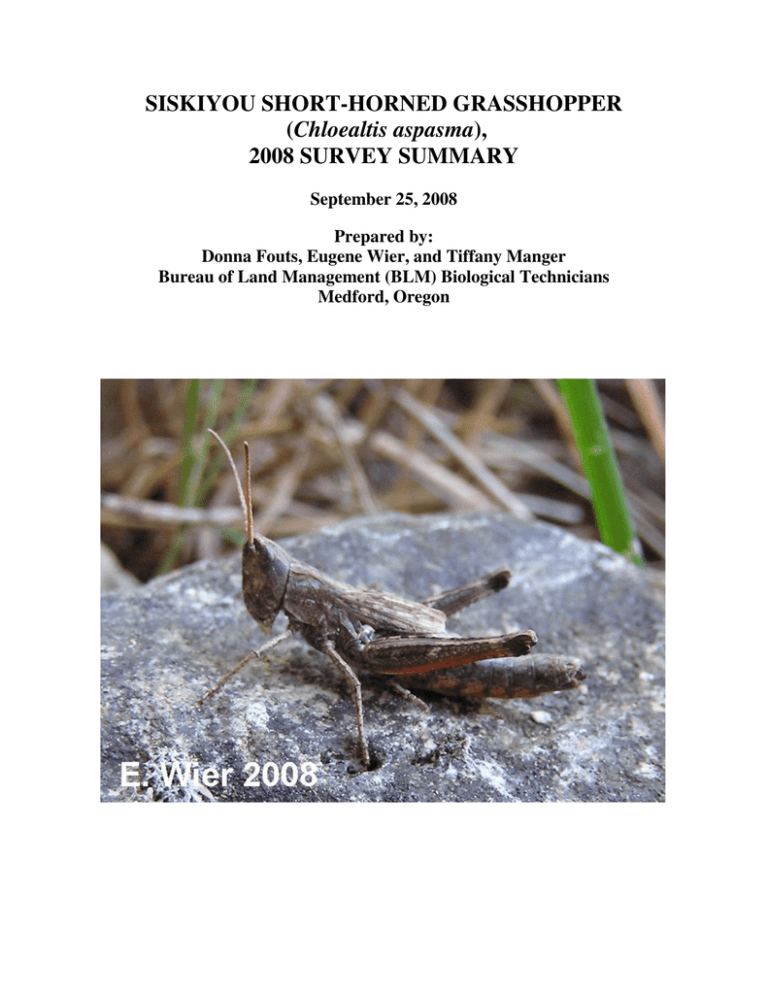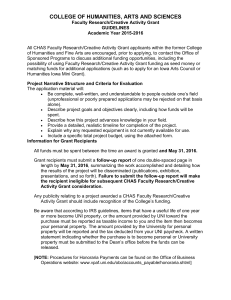SISKIYOU SHORT-HORNED GRASSHOPPER Chloealtis aspasma 2008 SURVEY SUMMARY
advertisement

SISKIYOU SHORT-HORNED GRASSHOPPER (Chloealtis aspasma), 2008 SURVEY SUMMARY September 25, 2008 Prepared by: Donna Fouts, Eugene Wier, and Tiffany Manger Bureau of Land Management (BLM) Biological Technicians Medford, Oregon INTRODUCTION The Siskiyou short horned grasshopper (Chloealtis aspasma) (CHAS), family Acrididae, subfamily Gomphocerinae, first described in 1919 (Rehn and Hubard) is thought to be rare and perhaps endemic to the Klamath-Siskiyou eco-region. The distribution, abundance and population status of this species are not well understood. Prior to our 2008 survey effort it had been known from voucher specimens collected at five locations in southern Oregon and 1 in west central Oregon, Benton County. The occurrence record from Benton County (1 voucher specimen) is considered suspect because return surveys over multiple seasons have failed to redocument the species at this site (Greg Brenner, personal communication). Adult CHAS range between 17-24mm in length. Their bodies are argus brown to grey in color. They have a slanted face and wings that do not obtain the length of the abdomen (Capinera, Scott, Walker, 2004). The wings tend to be wider at the tip than at the base and are more elongated in males than females. The ventral side of the abdomen and the tibia often has an orange coloration, while the hind femora is the same color as the body and often has black spots or freckling on the upper carinae (Otte,1981). There is an hourglass like constriction of the lateral ridges on the pronotum. In summer of 2008, as a result of improved identification skills and a larger collection of voucher specimens, it was realized that a similar species, the meadow grasshopper (Chorthippus curtipennis) (CHCU) can, and often does, occur at the same locations as CHAS. (CHCU) is lighter in color (more to the tan or yellowish side), has a darker line that borders the constriction on the top of the pronotum, and has foveae, where CHAS lacks foveae (Brenner, unpublished diagram 2008). Refer to Appendix A for comparative diagram. CHAS habitat is defined by the few sites where they have been collected. These sites were clear cuts and naturally formed grassy meadows which contain a component of grasses, forbs and sometimes blue elderberry (Sambucus caerulea). These clearings were often bordered by fir and less often pine forest. Elderberry is thought to be the preferred plant host for female CHAS to lay their eggs. (Brenner, 2005). 2 The BLM has designated Chloealtis aspasma (CHAS) as a Bureau Sensitive species under the Interagency Special Status Species Program (ISSSSP) and its current federal status is listed as a species of concern due to the limited number of sites from which it is known and lack of knowledge about habitat requirements and trends in its population. A survey of 17 sites, encompassing roughly 600 acres of potential habitat, on BLM and USFS lands was conducted by BLM staff in summer of 2006. This survey found CHAS at only two locations and in low abundance. In summer 2008, BLM surveyors revisited the same 17 sites, plus 27 others, in another attempt to document and better understand the distribution of this species. METHODS Between 29 July and 13 September 2008, 44 sites were surveyed by three BLM biological technicians. A “site” was determined using the software program ArcMap and digital orthoquads (DOQ) in combination with surveyor experience of the landscape and the best available descriptions of potential habitat for the target species. We chose sites that had open meadows or glades (natural or man made) with a variety of grasses and forbs, contained some component of perennial or seasonal wetland, and were within the range of elderberry (present or not). Site elevation ranged between 2,400’-6,700’ elevation. Visual encounter surveys (VES) were the method of detection. One or two surveyors performed timed VES surveys at each site. Surveyors used visual (vegetation types, moisture levels, sunny areas, etc.) and intuitive cues to guide searches. Survey times ranged from ½ hour to 4 hours depending on the size and complexity of the site and abundance of both target and non-target species. Effort was made to survey the full range of habitat variability within a given site (i.e. dry grasses, wetlands, forest edge, brushy areas, and rocky areas). A UTM coordinate in NAD83 datum for each site was collected at the time of survey. The point location where CHAS were observed or captured was recorded. If no CHAS were found at a site, the point was taken at a location that was thought to represent the habitat surveyed at that location. A polygon representing each area surveyed was drawn onto ortho/topographic maps of the specific sites in the field and later into a GIS data base of survey sites using ArcGIS9. Ten sites were revisited 3 more than once in the 2008 season in an attempt to follow and document, through vouchers, the development of CHAS instars and/or to try and locate CHAS specimens. Surveyors attempted to collect a voucher representative sample specimen of all Orthoptera species found at each site. As well as documenting the presence or absence of the target species, data such as temperature, elevation, aspect, slope, grazing and level of grazing pressure, presence or absence of elderberry, start and end survey times, and associated vegetation types were recorded for each site visited. Greg Brenner, an entomologist/biometrician at Pacific Analytics LLC., in Corvallis, Oregon, made and/or confirmed the Orthoptera specimen identifications. Animals were captured in sweep nets (7600 standard series 15”) or by hand, and placed in 2 oz. plastic jars for observation and identification. If an animal was chosen to become a voucher it was quickly placed in a kill jar containing a small quantity of ethyl acetate. Animals were removed once dead and placed inside 2 oz. containers, labeled with site name, collector, date, location (UTM) and elevation. Each day after returning from the field all sample jars from the day were packed with cotton to pad samples and placed in a freezer. Much of the mounting of voucher specimens was done by Donna Fouts, Tiffany Manger, and Eugene Wier. Final identification, labeling and mounting was performed by Greg Brenner of Pacific Analytics, LLC. All voucher specimens are housed with Steve Godwin, Wildlife Biologist, Ashland Resource Area, Medford District, BLM, in Medford, Oregon. RESULTS The distribution and abundance of CHAS in Jackson County, Oregon is larger then previously suspected. Chloealtis aspasma (CHAS) were found at 15 of the 44 sites surveyed (Appendix B). CHAS were found in 7 of the 17 sites surveyed in 2006. 4 Figure 1. Chloealtis aspasma survey locations during 2008. Green stars represent survey sites where CHAS were detected. Red dots depict survey sites where none were detected. The Sturgis Fork location to the southwest and the Woodruff Meadows location to the northeast are beyond this maps boundaries. The BLM surveyors detected CHAS approximately 30 miles farther west than previously documented locations. CHAS were found on both the Siskiyou and Cascade Mountain Ranges and on both BLM and US Forest Service managed lands (Figure 1.). There were 75 surveyed polygons within the 44 sites surveyed totaling 533.6 acres with a mean size of 7.1 acres. The smallest survey polygon was 0.00013 acres and the largest was 52.7 acres. Populations were clustered and not dispersed evenly within survey polygons. 5 Second and third instar nymphs of CHAS were found beginning 29 July, at the Hobart Peak site, the first date of the 2008 surveys. Underdeveloped wings and less than 17 mm body length implied instar stages. Nymphal CHAS were usually light gray in color whereas nymphal CHCU tend to be yellowish to tan in color. Adult CHAS were first captured approximately 15 August 2008. Surveyors assumed specimens were adults when developed wings and/or ovipositors were present. Figure 2. Adult Chloealtis aspasma found at Hobart Peak Survey Site in the Cascade Mountains 03 September, 2008. 6 Figure 3. Adult Chloealtis aspasma found at the Wrangle Gap site in the Siskiyou Mountains 26 Aug, 2008. Another grasshopper in the Acrididae family, the meadow grasshopper, Chorthippus curtipennis, (CHCU), was found at 22 of the 44 survey locations. Both CHAS and CHCU were found at 9 locations. Before the 2008 survey, it was not known that CHCU inhabited Southern Oregon (G. Brenner, per conversation 2008). Habitat conditions varied among sites surveyed. The elevation of surveys ranged from 2,424’ and 6,700’ with an average of 4,733’ elevation. CHAS were found between 3800’ and 6700’ elevation with an average of 5,065’ elevation. Of the 15 sites where CHAS were located, six sites (40%) had elderberry plants present and 9 sites (60%) did not. Signs of recent fire presence was absent at all sites surveyed. Surveyors took note of grazing activity on the “2008 Arthropod Site Form” at each site. Signs of grazing 7 in the 2008 survey year were observed at 51.6 % (n= 31) of the 60 sites visited. The surveyors noted grazing activity and recorded it into one of four categories (Table 1.). Some level of cattle grazing was detected at 32 of the surveyed sites. Of the 10 sites revisited, it was noted that cattle grazing pressure increased at two of them. Figure 4: Hobart site post cattle grazing (2nd visit). Photo by Donna Fouts 8 Grazing Activity by Visit Sites C. aspasma present Sites with no C. aspasma detected * Less than 7 days ago Site visit n=20 8-29 days ago Site visit n=6 More than 30 days ago in 2008 Site visit n=6 None detected Site visit n=28 30.0 %* n=6 33.3 %* n=2 16.7 %* n=1 21.4 %* n=6 70.0 %* n=14 66.7 %* n=4 83.3 %* n=5 78.6 %* n=22 percentage of detection within grazing activity category during the 2008 CHAS survey season Table 1. Comparison of sites where C. aspasma were found compared to current 2008 year grazing activity at time of survey. Air temperatures during surveys ranged from 56◦F to 101◦F. At sites that CHAS were found the air temperature ranged from 68◦F to 86◦F. Three survey visits did not have recorded temperatures. CHAS were present at two of those three sites. Soil temperatures and relative humidity were not recorded during the 2008 surveys. DISCUSSION There are a number of factors that may have contributed to the presence and/or detection of CHAS in the 2008 surveys. The time of year when CHAS emerge as instars and are moving freely as they graze, in addition to variation in summer temperatures, may be the strongest contributing factors to additional CHAS present sites. The 2006 surveys were conducted primarily in June when lower air temperature and higher precipitation potential may have inhibited the movement of CHAS. In addition to weather, the size and development of the grasshoppers may not have been advanced enough for easy detection by the surveyors in 2006. Results in 2008 suggest that delaying survey timing to mid- to late summer may improve detection probability. The specific locations surveyed during the 2008 survey may not have been the same locations surveyed in 2006 due to the generalized location descriptions of some 2006 sites. Selection of survey locations later in the season may have increased the likelihood of choosing locations 9 at which moisture gradients are consistent throughout the year. By focusing surveys in areas of green grasses and forbs, as well as being at those sites at a time when CHAS were more developed, the surveyors increased the likelihood of detecting the target species. Factors contributing to suitable habitat, though not supported through specific collected data, were mentioned by the surveyors. Northern facing aspects, vegetation less than 12” tall, vegetation covering less that half of the soil, and vegetation containing moisture during the month of August on mostly dry soil interspersed with rocky areas, tended to be favorable features of the landscape (Figure 5.). These habitat features, which are finite and not evenly dispersed, may account for the clustered nature of individuals of CHAS found. Surveyor observations of “suitable habitat” did not predict CHAS presence in all cases. Grizzly Rim and Pilot Rock appeared to contain suitable habitat yet CHAS were not found. This suggests there are factors controlling CHAS presence that are not clearly understood. Figure 5. Wrangle Gap Survey Site on 26 August, 2008 depicting CHAS habitat. Photos by E. Wier Because elderberry was not present at 60% of locations where CHAS was found, we believe that contrary to previous thoughts, CHAS are not limited to laying eggs in elderberry, but instead, may opportunistically use other vegetative substrates. Decaying wood was present in all locations at which CHAS were found. At the Roadside site, we were pleasantly surprised to find CHAS present though no elderberry was present and there was a slight (≈3%) southern aspect. Snowberry (Symphoricarpos albus) was another shrub that was present in many, but not all, locations CHAS were observed. Corn Lilly (Veratrum californicum ) were also observed at many sites at which CHAS were present. 10 CHCU individuals also seemed to be clustered in certain habitat “patches”. These areas were associated with wetlands and tended to have 2-6” tall grasses that was slightly drier than surrounding sedge dominated wetland flora. CHAS at the same sites were more often found on drier upslope habitats along margins of wetland and forest edges. The affects of cattle grazing on CHAS habitat are not fully understood but should be considered. While extreme destruction to elderberry plants was observed at Hobart Peak and Grizzly Rim, CHAS were present at both locations. It could be that live elderberry is an important predictor as is the presence of dead and decaying wood of the nature found on mature elderberry plants. CHAS literature describes dead decaying wood as the preferred material for ovipositing for similar Chloealtis spp. CHAS were often found in sparse grasses and perennial broadleaf plants less than 12 inches tall. This is often the condition of vegetation after grazing. For a study into the effects of grazing on CHAS, it would be informative to compare long term grazing allotment data to presence of CHAS over several years to understand both positive and negative correlations. We recommend additional surveys be done in the future to help learn more about the life cycle and habitat requirements for the Siskiyou short-horned grasshopper Chloealtis aspasma. These surveys should build on habitat information and site descriptions obtained in 2008. Surveys should take place over multiple seasons at the same sites to better understand annual fluctuations in populations and the potential effects of seasonal variations in temperature and moisture on life cycle timing. The documentation of 15 sites with CHAS present with signs of some grazed by cattle and others not, opens the door for a study into the effects of grazing on this species. 11 Acknowledgements We would like to acknowledge the work of Steve Godwin for procuring funding and for oversight, Steven Haney for 2006 surveys and report, Evan Gannon for his help in collecting samples, Greg Brenner for his identification expertise and for sample preservation training, and Carol Jorgenson for encouraging BLM to research this species further. 12 References Cited Brenner, Greg. 2008. Personnel communications with Medford BLM staff via phone and in person interview. Brenner, Greg. 2005. Species fact sheet. Technical paper prepared for Medford District – BLM Interagency Special Status Species Program (ISSSP) Capinera, John L., Scott, Ralph D., Walker, Thomas J.. 2004. Field Guide to Grasshoppers, Katydids and Crickets of the United States. Cornell University Press. Haney, Stephen L. 2006. Siskiyou Shorthorned Grasshopper Inventory. Internal project summery/report prepared by and for Medford BLM. Otte, Daniel. 1981. The North American Grasshoppers. Vol. 1, Acrididae. Harvard University Press. Rehn, James A., Hebard M. 1919. A new species of grasshopper of the genus Chloealtis (Acrididae) from the Pacific Northwest. Transactions of the American Entomological 13 Appendix A 14 Appendix B Date 04Sep-08 14Aug-08 28Aug-08 19Aug-08 02Sep-08 27Aug-08 08Sep-08 12Aug-08 26Aug-08 27Aug-08 03Sep-08 05Aug-08 18Aug-08 30-Jul08 25Aug-08 6-Aug08 25Aug-08 18Aug-08 02Sep-08 27Aug-08 06Aug-08 25Aug-08 27Aug-08 04- Site name Antelope Creek Baldy Mountain CHAS Bear Gulch Bieberstedt Butte Big Elk Creek Road yes CHCU Elev. (ft) Grazing level yes 4890 L yes 4970 Air (F) Location Surveyor 77 T38S-R02E-S03 Donna Fouts N 94 T40S-R03E-S17 3800 N 74 T41S-R02E-S05 Donna Fouts D. Fouts, E. Wier 4510 N 69 T36S-R03E-S29 Eugene Wier 4597 N 74 T37S-R04E-S09 Donna Fouts Bowen Creek 4061 N 75 T36S-R02E-S01 Donna Fouts Box O 3400 R 88 T40S-R04E-S22 Eugene Wier 5400 L 75 T38S-R03E-S33 Donna Fouts 5400 L 66 T38S-R03E-S33 Donna Fouts 5190 L 78 T39S-R03E-S07 Eugene Wier 5013 L 72 T39S-R03E-S07 Donna Fouts 4200 N 80 T39S-R03E-S26 3520 N 74 T39S-R03W-S35 Eugene Wier Tiffany Manger 4455 L 86 T38S-R03E-S05 Donna Fouts 4455 L 61 T38S-R03E-S05 Donna Fouts 4705 M ? T38S-R03E-S-21 4722 M 60 T38S-R03E-S-21 Donna Fouts Tiffany Manger 4025 N 72 T39S-R02W-S10 Eugene Wier 4350 L 76 T36S-R03E-S07 Donna Fouts 5535 N 75 T38S-R04E-S26 Donna Fouts 4934 N 86 T38S-R02E-S07 Donna Fouts 4934 N 64 T38S-R02E-S07 Donna Fouts 4900 5074 L L 71 74 T38S-R02E-S07 T38S-R02E-S07 Eugene Wier Donna Fouts Buck Prairie yes yes Buck Prairie Burnt Creek Burnt Creek Chinquapin Mtn yes yes yes Cinna-Boaz Conde Creek yes yes Conde Creek Dead Indian yes Dead Indian Demming Gulch Esmond Mountain yes Griffin Pass yes Grizzly Rim Grizzly Rim Grizzly Rim Grizzly Rim yes 15 Sep-08 04Aug-08 19Aug-08 29-Jul08 19Aug-08 03Sep-08 29-Jul08 19Aug-08 03Sep-08 12Aug-08 26Aug-08 30-Jul08 26Aug-08 12Aug-08 13Aug-08 15Aug-08 20Aug-08 05Sep-08 11Aug-08 26Aug-08 06Aug-08 28Aug-08 18Aug-08 27Aug-08 25Aug-08 18Aug-08 Heppsie Mountain Heppsie Mountain yes yes Hobart Peak Hobart Peak yes Hobart Peak Hobart Peak #2 Hobart Peak #2 Hobart Peak #2 E. Wier, T. Manger 4220 R 85 T37S-R03E-S05 4220 M 68 T37S-R03E-S05 5300 N ? T40S-R03E-S16 Eugene Wier D. Fouts, E. Wier, T. Manger, G. Brenner 5300 L 61 T40S-R03E-S16 Donna Fouts 5300 L 70 T40S-R03E-S16 5475 N ? T40S-R03E-S21 Donna Fouts D. Fouts, E. Wier, T. Manger, G. Brenner 5475 L 71 T40S-R03E-S21 Donna Fouts 0 L 73 T40S-R03E-S21 Donna Fouts Hoxie Creek yes 4730 M 82 T38S-R04E-S17 Eugene Wier Hyatt Lake yes 5093 N 72 T39S-R03E-S03 Donna Fouts 5760 N 82 T38S-R03E-S29 Donna Fouts 5760 R 69 T38S-R03E-S29 5330 N 67 T38S-R03E-S29 Donna Fouts D. Fouts, E. Wier 5455 N 86 T38S-R03E-S29 Donna Fouts 2757 N 101 T40S-R02W-S10 Donna Fouts John Denver John Denver Johnny Cash yes yes yes Johnny Cash Kenny Meadows Lake Creek yes 3700 R 73 T38S-R02E-S13 Eugene Wier Lick Gulch yes 2424 N 76 T39S-R02W-S27 6700 N 75 T40S-R01E-S20 6700 N 56 T40S-R01E-S20 Donna Fouts D. Fouts, E. Wier E. Wier, E. Gammon Mt. Ashland yes yes Mt. Ashland North Chinquapin yes 5360 L 80 T39S-R03E-S23 Pilot Rock yes 5050 N 76 T41S-R02E-S03 Eugene Wier D. Fouts, E. Wier Pool Hill yes 3450 L 81 T37S-R03E-S17 Donna Fouts 5031 N 77 T38S-R04E-S35 Donna Fouts 3870 L 76 T40S-R04E-S19 Eugene Wier 4450 L 75 T39S-R01W-S28 Eugene Wier Roadside Rosebud Mountain Second Water Gulch 16 27Aug-08 19Aug-08 13Sep-08 15Aug-08 05Sep-08 02Sep-08 12Aug-08 12Aug-08 05Aug-08 20Aug-08 26Aug-08 KEY: Section 35 Gravel Pit Soda Mtn South Sturgis Fork yes 4637 N 77 76 T38S-R04E-S35 T40S-R03ES27/28/35 T40S-R08ES19/24 yes 4069 L 76 yes 5100 R Eugene Wier 4991 N 99 T39S-R04W-S11 Eugene Wier 2619 N 83 T40S-R04W-18 Donna Fouts 4933 N 70 T37S-R04E-S26 Donna Fouts yes 5250 N 68 T39S-R03E-S27 Eugene Wier yes 4610 R 83 T37S-R03E-S31 3085 M 95 T31S-R03E-S07 3085 M 67 5640 L 73 T31S-R03E-S07 T40S-R01WS29/32 Donna Fouts D. Fouts, T. Manger D. Fouts, T. Manger Tallowbox Thompson Creek USFS050 West Chinquapin yes West Glades Woodruff Meadows Woodruff Meadows Wrangle Gap yes yes historic site 2006 survey site 2008 survey site L= less than 7 days ago R= 8-29 days ago M= more than 30 days ago this year N= none detected 17 Donna Fouts Donna Fouts Eugene Wier








